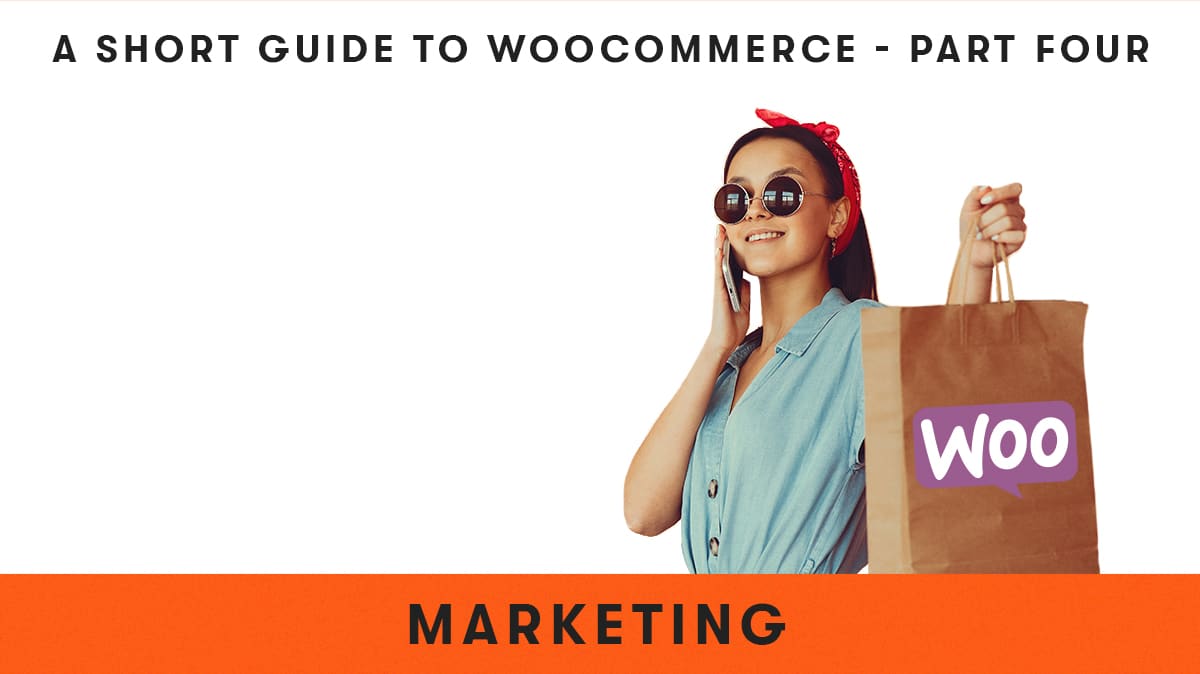WooCommerce has a number of functions to facilitate effective marketing of your online store. The two areas of marketing you need to consider are on-site and off-site. By on-site we mean content, features, and functions that exist in the website itself. Off-site refers to external platforms that we use to bring traffic to your website. You can set up the on-site marketing functions and then use off-site to promote them and use them to bring purchasers to your website.
On-Site
Sale Pricing
A default function of WooCommerce is the ability to set a sale price. This price is shown as a discount to the regular price. When you enter a sale price in WooCommerce, the regular price is normally (depending on the front-end development) shown to the user with a strikethrough and the item has a sale badge making it stand out. Sale items become a kind of “category” so you can have them appear in designated areas of your website such as a dedicated on-sale page, or as a feature area on the home page.
 With a bit of custom development, it is possible to have a third tier of pricing. This could be used by stores that have pricing that is already different from regular retail. The third tier allows you to show the recommended retail price with a strikethrough, then your price, with the ability to have a sale price on your price as well if required.
With a bit of custom development, it is possible to have a third tier of pricing. This could be used by stores that have pricing that is already different from regular retail. The third tier allows you to show the recommended retail price with a strikethrough, then your price, with the ability to have a sale price on your price as well if required.
Coupon Codes
Coupon codes are a default function in WooCommerce which you can use to offer promotional or loyalty-based discounts. You can set your own coupon codes with fixed product discounts (amount of one or more specific products), fixed cart discounts (amount of the cart total price), or percentage discounts (percentage off the cart total price). You can also use coupon codes to offer free shipping.
You can set limits to the number of times the coupon can be used in total and per user. You can set an expiration date on the coupon.
Another default feature is the ability to set restrictions so that the coupon code is only applicable to a minimum or maximum spends, when certain selected products are in the cart, or product categories. You can also set your coupon code to not be applicable on sale items.
Loyalty Points
Although not a default function of WooCommerce out of the box, a loyalty point system can be developed into your store. Frequent customers with user accounts can have points applied to their account based on amounts spent or quantities purchased. The points can accumulate and be used to offer a free product when an amount is reached. Just like a coffee card.
Abandoned Carts
Cart Abandonment functions are a great segue from on-site to off-site marketing. When a user adds products to their cart, proceeds to the checkout and does not complete the purchase – this is called cart abandonment. There are many reasons why a user mightn’t complete the purchase, most often it will be because it may be the first time they see the shipping costs applied to the total and therefore opts out. However, there are other reasons such as distraction, payment method uncertainty, and plain old change of heart.
WooCommerce allows for the addition of functions which can be set up to send an email to the user reminding them they have an incomplete checkout. This can be useful simply as a reminder but is more effective as an incentive-driven nudge. Using a third-party application you can craft cart abandonment emails to obey certain conditions and contain coupon codes that offer a discount for the user to complete their purchase.
Just to dispel what might be a bit of a privacy concern, the cart abandonment functionality only works when the customer is signed into their account, or they have gone as far as entering their email address in the checkout and the checkout page is left open in a browser for a set period of time.
Off-Site
The off-site marketing you can employ for your online store includes social media marketing, pay-per-click and social media advertising, social media shopping functions, and email marketing. Utilising these methods to lift your sales is one thing, but measurement is vital to ensure you are receiving a return on your investment. Therefore, you will need to be aware of analytics, conversions, tracking codes and tags, and pixels.
Social Media Marketing
Like all businesses, social media and content marketing can be a low-cost way of driving users to your products. A strategy of publishing content on your website and broadcasting it via your social media channels can boost your organic SEO and increase your channel audience. Writing about featured products, features and benefits, how-to-guides, customer testimonials, and special offers exclusive to your followers present a rich pool of content. Posting on social media channels requires you to be aware of the right image size for your post. Click here for more about post styles and image sizes. The good news about WooCommerce, because it is WordPress, there is the ability to have functions configured that allow you to upload and set an image specifically for each social channel, and also to have the ability to post directly to your social media from your website when you add a new product or promotional content.
Pay-Per-Click & Social Media Advertising
If you are starting out with your online store, your social audience may not be populous enough to be effective in driving sales. Pay-per-click can allow you to both lift your audience and promote your goods. Google Ads allows you to target ads that link back to your store, product category, or the product page.
Google Ads delivers ads to users according to the relevancy of their search to your set of keywords in your AdGroups. This works as your ads will appear to people who are actively searching for the products you sell.
Google Merchant is an Ads feature related to GoogleAds, these are the visual shopping ads that appear in searches in the top right of a product search engine results page (SERP). These are effective if your price is competitive, as these ads present a clear way for users to compare price before clicking. These ads take some time to set up if you do not have the technical knowledge to create a feed or to individually enter in each product, however, WooCommerce has an extension that allows you to create a feed and connect to Google Merchant that updates your ads as your store updates.
Social Media paid advertising can be effective because of your ability to target advertising your product to very specific demographics. For example, in Facebook, if you are selling products for weddings, you can target females, within an age range, within a geographic area, whose relationship is engaged and who are interested in weddings. This means your ad only appears to likely purchasers. Using paid advertising on Facebook and Instagram (ads on Facebook appear on Instagram by default) allows you to reach users beyond your website audience and increase that audience while increasing sales.
It is important to consider when choosing your pay-per-click strategy the differences in how users see your product. With Google Ads, the user has actively searched it out, they are in the research stage of the sales funnel. Because they have searched, they are seeing your product and service among those of your competitors, they can easily price compare, as well as sub-consciously compare the user experience of your website with your competitors. If your price is competitive, and your website user experience is superior, you will succeed in converting the sale. However, if your product is priced higher than competitors and you do not clearly demonstrate your value, you will be less likely to get the sale.
With social media advertising, however, the user has not necessarily actively searched for your product or service, however, your ad will appear because they are in your chosen demographic and are likely to be interested. If your ad makes a compelling offer you are likely to make a sale based more on impulse than intent. The user sees only your ad (usually) and there is more effort required to compare prices.
Remarketing (combining GoogleAdwords with Social Media Marketing)
Remarketing is one way to leverage both organic and paid search engine advertising and social media advertising. This can be very effective because your Facebook and Instagram ad only appears to users who have visited your website or more specific product pages. A user who has seen your google ad and not purchased will then be served your product ad in their social media feed reminding them of your offering and reinforcing your brand with your product category.
Social Media Shopping
Both Facebook and Instagram have their own shopping functions. WooCommerce allows you to connect to the Facebook network to feed your products for sale to your Facebook page or tag products that connect to your product page from Instagram posts. Both these functions are free (they are not ads) and they allow you to bring the purchase capability forward to your users and lower the friction in the purchase experience. They are also effective at attracting impulse purchases.
eNewsletter Campaigns
Your eNewsletter is also a tool you can use to inform your existing contact list of your products and services available for sale on your website. Treat your contact list as VIPs and offer exclusive deals. WooCommerce offers an extension that syncs your website customer list with your Mailchimp audience which enables you to target emails based on shopping behaviour. This is a very powerful tool for such things as cart abandonment emails, up-sell offers, birthday deals, loyalty offers, and to send timed emails requesting product feedback and reviews.
Measurement
For both types of paid advertising mentioned above, and for all online marketing to be effective, you will need to be able to analyse performance. Ensure you have a Google Analytics tracking code or Tag Manager tag installed on your website. Beyond that, you will need to configure the eCommerce Settings & Conversions settings in your Analytics and Adwords accounts, so you are able to track how effective your organic and paid campaigns are working.
For Facebook campaigns targeting sales, you will need to ensure you have a Facebook Pixel installed on your website, and that the Pixel is configured for eCommerce actions such as add to cart, initiate checkout, purchase. You will then be able to see the cost per goal of each of your campaigns.
Conclusion
If your website is mature, you might be ok with organic SEO and existing marketing to bring enough traffic to generate the sales required to make a profit. However, if your online store is a new offering you will need to equip your store for marketing and analytics. Thankfully WooCommerce makes it easy to ensure you have all the tools you need to reach your audience, promote sales, and measure effectiveness.




